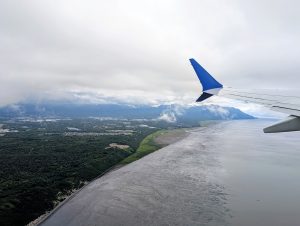2025: A Year of Aviation.
In March of 2025, I passed my commercial glider checkride. So I can, legally at least, tap into the lucrative world of flying gliders for money (that’s a joke). In May, I started hanging out with EAA chapter 1627 in Boulder, Colorado. Among many other things, I am excited to get my hands dirty rebuilding and then hopefully flying an ultralight aircraft. And with any luck, soon we’ll begin finishing a Murphy Rebel.
In July, I will be attending EAA’s AirVenture at Oshkosh, Wisconsin for the first time in over 20 years. I’ll be flying the arrival with an accomplished aerobatic pilot, volunteering for some chapter fundraising events, and spending two days in a sheet-metal workshop to hone my skills for upcoming projects.
But June was the highlight. The pinnacle. The apex of a spirited turn in the direction of my life and flying career, in which one of my oldest childhood daydreams was finally (and quite spectacularly) realized.
In June, I traveled to a little town called Moose Pass on Alaska’s northern Kenai Peninsula, to learn how to fly seaplanes.
Yes, it was [expletive] amazing.
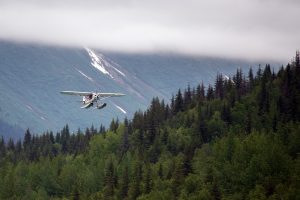
But Why Seaplanes?
Seaplanes unlock parts of Alaska that even the most STOL-capable, fat-tire bush planes cannot go. Don’t get me wrong, the fat-tires are every bit as fun, and in some places they are the only way to get around. But in a forested landscape dotted with lakes and rivers, like parts of Alaska and much of northern Canada, seaplanes are in their element.
While you might be able to land a wheel-plane somewhere in that landscape, your options are limited and the odds of being able to take off again are marginal. Seaplanes, on the other hand, turn every waterway into an airfield and every tiny beach into a potential fishing spot.
Of course, you wouldn’t choose a seaplane in the American mountain west, or anywhere else in which navigable water is scarce. So floats or wheels (or skis, even) isn’t a question of which one is better overall. It’s a question of which one is best for the mission of the day.
And being a Minnesota boy, my daydreams most often involve water. In fact, one of my earliest aviation memories is standing on a dock in northern Wisconsin, watching in amazement as a plane circled overhead and then landed on the lake in front of us. On the lake! I was dumbstruck. My understanding of the world was totally upended.
The airplane docked at the cabin next door, and us kids sprinted over to get a closer look at that incredible machine. To our amazement, the pilot offered to take us for a ride, and our parents let us climb aboard with this total stranger. We took off and circled the lake a few times, for the first time looking down from the heavens at what was until then a small, familiar place.
I’m pretty sure that was the moment my brain short-circuited, financial prudence went out the window, and the aviation bug made a nice home for itself inside my soul.
The rest, as they say, is history.
Moose Pass, AK
Moose Pass is a quiet little town about 40 minutes north of Seward. It is home to one of Alaska’s first and oldest public libraries, and has been an important stop on the land routes between Anchorage, Hope, and Seward for more than 100 years. The infamous Iditarod trail passes passes through town before continuing north toward Johnson Pass and Turnagain Arm. The Alaska railroad also passes through, these days hauling tourists instead of gold ore, mail, and other supplies.
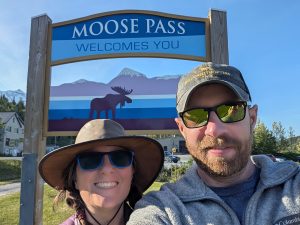
It is a friendly place. All of the people we met were very nice, and about the only thing they don’t like about outsiders is how fast they drive through town (the speed limit is a strict 35 miles per hour). Rumor has it the old Estes waterwheel still turns a grinding stone, with a sign that reads: “Moose Pass is a peaceful little town. If you have an axe to grind, do it here.”

There is a convenience store with fantastic coffee and a few grocery items, a restaurant and bar attached to the motel, a post office, and a couple of put-ins if you happen to bring a boat. If you can’t find what you need in Moose Pass, you can drive 40 minutes down to Seward, which has a full grocery store, a laundromat, a bank, and dozens of restaurants.
Seward is worth visiting anyways, as it’s a beautiful drive from Moose Pass and there are plenty of interesting things to see. Like the monument at Mile 0 of the Iditarod trail. It’s a few hundred yards from the “real” start, but it’s a nice park anyways.
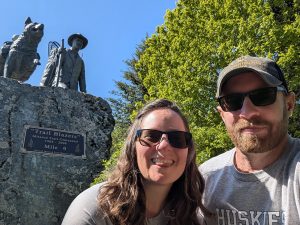
Seward has a deep-water port, so the cruise ships also dock there. It’s never felt right to me, coming into a town and seeing those behemoths parked there. But to each their own. I can certainly see the appeal of a cruise, it’s just not for me.
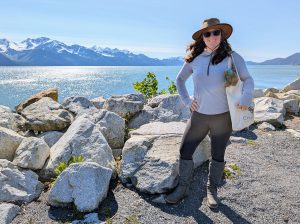
Alaska Float Ratings
Moose Pass is also home to a small family-run business called Alaska Float Ratings (AKFR), which offers seaplane training to interested pilots. Under the same roof, they also operate Scenic Mountain Air, which offers scenic flights and rides to and from remote mountain lakes for adventurous hikers, fishermen, photographers, and hunters.
Alaska Float Ratings is a small operation. Normally they have a couple of Super Cubs and a couple of instructors, who split time between training prospective float pilots and giving scenic rides in a float-equipped Cessna 172 or 206. One of the owners is a designated pilot examiner (DPE), ordained by the FAA to grant ratings if he deems your performance satisfactory, so your entire journey from zero to checkride is handled in-house.
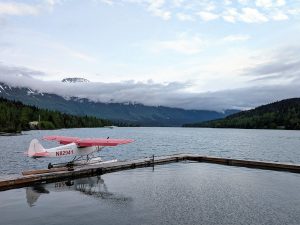
They also have a handful of one-room studio cabins onsite, and another that’s large enough to hold a family. I opted for the former. There is also a motel across the street, but it was booked as early as the previous November. The key takeaway is if you want to train at AKFR, start planning now for next season.
The Legendary Super Cub
The airplanes used for training at AKFR are Piper PA-18 150s, or Super Cubs. They have two seats in a tandem arrangement, which is front and rear, as opposed to side-by-side like in many other light aircraft. Up front is a 150 horsepower Lycoming engine, and down below are Edo 2000 straight floats.
Super Cubs are flown with the stick in your right hand, throttle in the left, like God intended. They may feel small, but 150 horses are plenty at sea level, and they have enough muscle to put a big, stupid grin on your face.
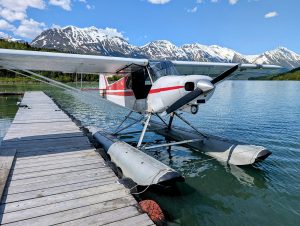
Super Cubs and Alaska go together like peanut butter and jelly, and they’ve become legendary over multiple generations. They’re tough airplanes, and can be fitted with wheels, floats, or skis. They can turn on a dime (even with floats), and will get you in and out of very tight places.
The first real confined-area takeoff I did in the Super Cub, on a tiny alpine lake in Johnson Pass, was very nearly a religious experience. I’m still wearing that big, stupid grin. You really have to experience it to believe it.
For a motorcycle guy, they’re kind of like a little dual-sport. Sure, they won’t cruise comfortably at 90 miles per hour on the highway, and won’t haul the kitchen sink. But they’ll get you from the garage to the woods just fine, and once you’re in the woods, you’ll be really glad you didn’t ride the Goldwing.
The Training
AKFR publishes much of their training material on their website, and expect you to show up having studied it already. You will get some ground time reviewing the material, but things will go a lot faster if you already hold some fundamental knowledge. If you’re a consumer of aviation media, these three video series are both highly entertaining and introduce some of the general concepts of float flying. In no particular order:
Depending on the weather and instructor workload, you can plan on one to three flights in a day. The training is broken down into five lessons, each with a specific goal and expectations. The program was refined over some 40 years, so it is very well-structured. It starts off with the basics and finishes with the more advanced. By the end of it, perhaps with a little review, you should be ready for the checkride.
Early on, one of the more helpful maneuvers for me was called “roller coasters.” You set up to land, touch the water only briefly, climb back up to 200′ or so, and do it again. It’s all about tuning your senses, feeling where the airplane is above the water, so you can judge when to start rounding out for landing. Like gliders, flying floatplanes is all about feel.
Kenai Lake, just a few minutes south of the base, is perfect for roller coasters. It’s huge, with parts that run straight for more than seven miles at a time. So you can do roller coasters until you’re bored, then turn around and do them again. Before you know it, you’ve got landing nailed down.
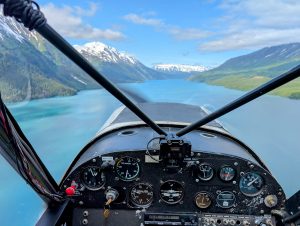
With so many lakes in the immediate area, you will have ample opportunity to find out what a Super Cub can really do. And in doing so, build the skills you need to make floatplanes a useful tool.
Evaluating lakes for wind and hazards, landing on rough and glassy water, beaching the airplane, and even sailing it in the wind with the engine off are all things you need to learn. And learning is best achieved when actually doing the thing.
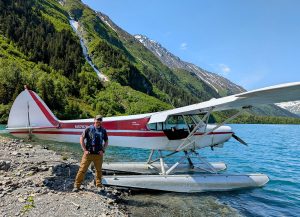
All things considered, I can’t think of a better place to train if flying floats is on your agenda. The owners and instructors at AKFR are all amazing people, and they really made the entire experience a memorable one. Five stars, 10 out of 10, A+ all the way down the list. Plus some bonus points for the nearly perfect weather!
Logging PIC
Anticipating learning difficulties, I paid up-front for a 10-hour block of flight time. But I took the checkride after six hours or so, which left me with some time to burn. Now we could go sightseeing, and I could log some pilot-in-command (PIC) time in the Super Cub!

This last day had some more typical Pacific Northwest weather, with a bit of rain and low overcast. It was a bit strange to me, feeling our way along just below the clouds. In Colorado if the clouds are this low, I stay home. But here, it’s just a normal flying day. The air was stable, the clouds were low but thin, and we were in Class G airspace so all we had to do was stay out of them to remain legal.
Still, in my head I was constantly reviewing our options if we had to land and hang out for a while. Which, honestly, would have been kind of nice – so long as the weather didn’t worsen and stay bad for weeks!
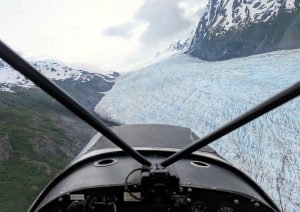
We flew over a couple of glaciers, and it was really something to feel all of that cold air tumbling down the ice. It creates some turbulence on its own, and it’s not hard to imagine the winds that rip down these valleys when storms come through.
Had it not been for the low clouds that day, we could have flown over the Sargent Icefield and checked out more glaciers where they meet the Pacific.
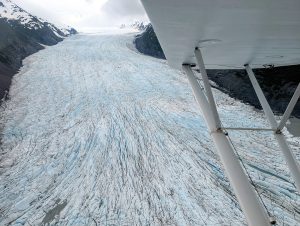
I wasn’t able to snap any photos of them, but we saw a few moose and a couple of black bears, along with a few bald eagles. What a great way to end an incredible week of Alaska flying!
My Turn!
Because I had so much time to burn, Melissa got up with my instructor for an intro flight.
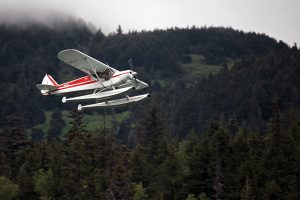
She got to take the controls and fly for a bit. And being in the front seat, she had to operate the flaps, carb heat, mixture, and engine starter.
When she got back to the dock, she was all smiles. And now that she knows what real flying is, as opposed to being bored to tears by a Cessna 172, she’s starting to agree that I need my own airplane.
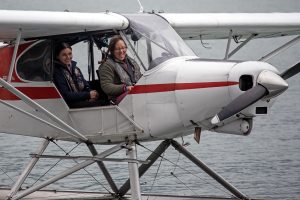
Time to start planning a build…
But Wait, There’s More
We took our time going back to Anchorage, so we drove to Whittier just to say we did it. There isn’t much there unless you’re into Cold War history or using it as a jumping-off point for adventures into Prince William Sound.

We had a day to spend in Anchorage before heading home. So we stopped by Lake Hood, the busiest seaplane base in the world, to watch airplanes come and go. We also visited the Alaska Aviation Museum, which is itself worth the trip to Anchorage.
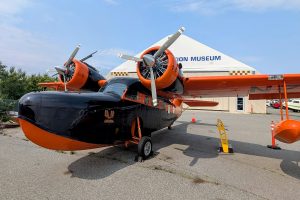
I won’t spoil the museum for you, but it houses many very unique aircraft and aviation artifacts. But it’s also a museum of Alaska’s history more generally, even though the overarching theme is aviation.
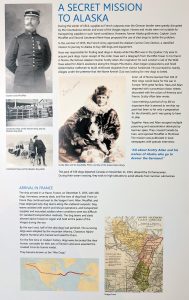
The jewel of it all for me was the exhibit on the Battle of Attu in the second world war. I had always known the Japanese took control of some of the Aleutian Islands in southwestern Alaska, but I did not know many details. The exhibit provided a lot of context, and it honestly left me speechless.
Through valiant effort, a P-40 Warhawk that was shot down during the battle was recovered in 1999. It is the only warplane ever shot down by enemy fire over North America. Largely through volunteer efforts, the museum is attempting to restore the P-40 to flying condition.
Until Next Time
This was our second trip to Alaska together, and we are already planning the next one. Ever since my first trip to Alaska in 2009, as a newly-minted geologist searching the region for tellurium, I’ve been hooked. I feel at home there, and I am humbled by its people, its places, and its history. And as an aviation nerd, it’s basically paradise.
Until next time!
